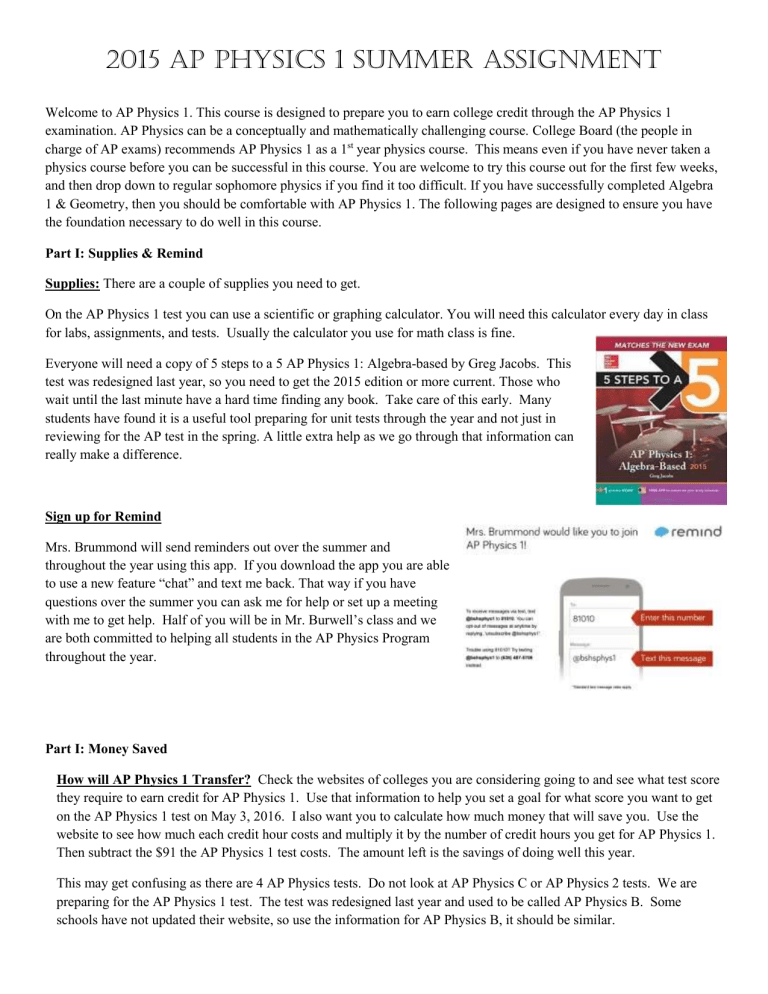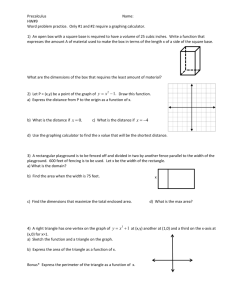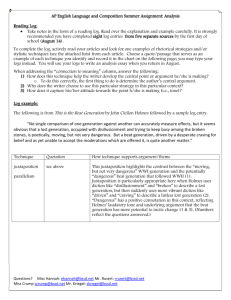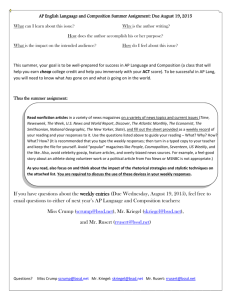2015 AP Physics 1 Summer Assignment Welcome to AP Physics 1

2015 AP Physics 1 Summer Assignment
Welcome to AP Physics 1. This course is designed to prepare you to earn college credit through the AP Physics 1 examination. AP Physics can be a conceptually and mathematically challenging course. College Board (the people in charge of AP exams) recommends AP Physics 1 as a 1 st year physics course. This means even if you have never taken a physics course before you can be successful in this course. You are welcome to try this course out for the first few weeks, and then drop down to regular sophomore physics if you find it too difficult. If you have successfully completed Algebra
1 & Geometry, then you should be comfortable with AP Physics 1. The following pages are designed to ensure you have the foundation necessary to do well in this course.
Part I: Supplies & Remind
Supplies: There are a couple of supplies you need to get.
On the AP Physics 1 test you can use a scientific or graphing calculator. You will need this calculator every day in class for labs, assignments, and tests. Usually the calculator you use for math class is fine.
Everyone will need a copy of 5 steps to a 5 AP Physics 1: Algebra-based by Greg Jacobs. This test was redesigned last year, so you need to get the 2015 edition or more current. Those who wait until the last minute have a hard time finding any book. Take care of this early. Many students have found it is a useful tool preparing for unit tests through the year and not just in reviewing for the AP test in the spring. A little extra help as we go through that information can really make a difference.
Sign up for Remind
Mrs. Brummond will send reminders out over the summer and throughout the year using this app. If you download the app you are able to use a new feature “chat” and text me back. That way if you have questions over the summer you can ask me for help or set up a meeting with me to get help. Half of you will be in Mr. Burwell’s class and we are both committed to helping all students in the AP Physics Program throughout the year.
Part I: Money Saved
How will AP Physics 1 Transfer?
Check the websites of colleges you are considering going to and see what test score they require to earn credit for AP Physics 1. Use that information to help you set a goal for what score you want to get on the AP Physics 1 test on May 3, 2016. I also want you to calculate how much money that will save you. Use the website to see how much each credit hour costs and multiply it by the number of credit hours you get for AP Physics 1.
Then subtract the $91 the AP Physics 1 test costs. The amount left is the savings of doing well this year.
This may get confusing as there are 4 AP Physics tests. Do not look at AP Physics C or AP Physics 2 tests. We are preparing for the AP Physics 1 test. The test was redesigned last year and used to be called AP Physics B. Some schools have not updated their website, so use the information for AP Physics B, it should be similar.
Goal for my score on the AP Physics Test May 3, 2016:____________
Savings calculations:
School used as a reference: __________________________________________
Number of credit hours I can earn by doing well on the test:
Cost per credit hour: a x b = $_____ - 91 = $_________ total savings by doing well and preparing for the AP Physics 1 Test a. _______ b. $______
Will this course count toward my major? Locate a 4 year course plan or degree requirements listing the course you need to take for your major on the college website of your choice. If your major requires physics, verify the physics course number that the test counts as credit for matches the course number for the class you have to take for your major.
If your major does not require physics, you will most likely need a physical science course with a lab in your general education requirements, so verify this course will count towards your general education requirements.
School used as a reference: __________________________________________
Academic Major: ____________________________________________________
What is the course code that AP Physics 1 receives credit for (example: Physics 1210)?
______________________________________________________
Is physics required for this major? ________________
If yes, what is the course code of the physics course required for your major? (example: Physics 2750)
_____________________________________
If no, what general science is required for your major? (Example: Must include 9 credits in these sciences: biological science, physical science, and / or mathematical science)
________________________________________________________________________________________________
________________________________________________________________________________________________
_____________________
Select one of the following options. a) My major requires physics and this course meets that physics requirement. b) My major requires calculus based physics. This AP test will not be accepted as credit for that course, but I will need the knowledge of this course to be successful in calculus-based physics. c)
My major doesn’t require physics specifically, but does require general science credit and this course fulfills the general science requirement. d) This course won’t help me towards my degree, and I probably should change my high school schedule.
Part II: Math Requirements
We will progress at a very fast pace and a basic understanding of some math is essential. The attached concepts are an integral part of this course, as they are skills you must be comfortable with from day 1. The more effort you put into this packet, the easier the beginning of the semester will be.
If you do not feel comfortable with one or more of the following skills/concepts, it is your responsibility to use the resources available to you (a friend, the internet, the reference sheet attached in the back of this handout, located at http://www.erikthered.com/tutor/act-facts-and-formulas.pdf) until these skills are second nature.
We will NOT spend class time on this material, so it is your responsibility to get it done outside of the classroom. This packet will also count as your first homework assignment.
Part III: Intro to Inquiry
In addition to the review of algebra and geometry, I would like for you to do some research this summer. Something semiscientific. This next year will have a large lab emphasis with much of the learning stemming directly from experimental observations. With that in mind, the second part of your summer assignment will involve making observations, doing research, analyzing data, and reaching conclusions based on popular YouTube experiments. Choose any ONE of the following for your short report to be turned in on the First Day of Class as part of your first grade.
Rubens tube Pendulum waves Singing Tesla Coil
Ooblek Toroidal vortices Cloud in a bottle Bed of nails
Again, the short report should include the following areas of focus:
I. Background/Research – How was the lab set up? What safety precautions must be taken? What key Physics
Relationship(s) does the lab exhibit? What significance does this relationship have in real-world contexts? (You’ll have to do a little digging beyond the video clip)
II. Observations – What observations can you make as you watch the lab? What measurements and data would you need to collect to support the relationship at play? Did the lab go as you expected? Were there any unexpected outcomes? In particular, be sure to include the following:
1. Record scientific observations and other scientists' findings regarding the phenomena.
2. Record any questions that come to mind when viewing the scientific phenomenon.
III. Analysis/Conclusions: What does the data obtained from the experiment suggest? What conclusions can you reach about the particular physics phenomenon you choose to study? What aspects, if any, are still unclear and would need further exploration? You must include:
3. Propose how a variable could be changed in the experiment and suggest a hypothesis for the results.
4. Locate a graph, table or equation associated with the scientific phenomena. Use mathematical reasoning to explain the model.
5. Locate a scientific explanation of the phenomenon, and evaluate the evidence leading to that explanation.
The report does not have to be a set number of pages or paragraphs (I would imagine less than one page would be fine), just do your best to respond fully to each of the sections listed above. Each numbered prompt must be addressed (ex: #1
Record scientific observations and other scientists’ findings must be addressed). It does not have to follow a certain format, but I would title each section as “Background,” “Observations,” and “Analysis.” If you have any questions or concerns about the assignment, please feel free to contact me at the below e-mail address. I look forward to a great year.
Good luck and enjoy your summer,
Mrs. Brummond and Mr. Burwell kbrummond@bssd.net
and bburwell@bssd.net
Helpful Geometry and Trigonometry Review:
Consider the diagram at the right, then answer the following:
1. What is line B in relationship to the circle? a) Secant b) Tangent c) Chord
2. Line A extends from the center of the circle, what is the angle measured between lines A and B?
Angle = _________
3. What is the measure of θ in the diagram below?
θ
142°
4. What is the measure of angle θ in the diagram below?
7
5. Find the area under the following graph:
10 22
30°
θ
B
A
Pythagorean Theorem - for any right triangle, a 2 + b 2 = c 2 , where:
c a
b
Find the unknown quantities for each right triangle given the information below, round to the nearest tenth.
6. a = 9, b = 9, c = _______ 7. a = 4, b = _______, c = 12 8. a = ______, b = 10, c = 13
Basic Trigonometry: Using Sine, Cosine, and Tangent for any right triangle.
Sin(θ) = opp hyp
; Cos(θ) = adj hyp
; Tan(θ) = opp adj
Use the following triangle to find the unknown information for questions 9 -12:
c
a
9. θ = 50° ; a = ______ ; b = 10; c = _______
10. θ = 60° ; a = ______ ; b = _________; c = 2
11. θ = ______ ; a = ______ ; b = 10; c = 15
12. θ = 45° ; a = 8 ; b = _______; c = _______
b
θ
Formula Manipulation: Some of the most difficult problems we’ll see in this course are those which require implicit manipulation of a formula (solving for one of the variables in terms of the others).
Solve the following relationships for the indicated variable:
13. v
2
= v
0
2
+ 2a(x − x
0
) ; Solve for a: a = ____________________
14. a c
= 𝑣 r
2
; Solve for r: d = ____________________
15. mgh =
1
2 mv 2 ; Solve for v: v = ____________________
16.
1
R 𝑒𝑞
=
1
R
1
+
R
1
2
: Solve for R
1
: d i
= _____________________
17. x = x
0
+ v
0 t +
1
2 at
2 ; solve for t: t = ______________________
18. F g
=
Gm
1 r 2 m
2 ; solve for r: r = ______________________
Solving a System of Linear Equations with Substitution:
Solve the systems using the substitution method:
19. 2𝑥 + 5𝑦 = 7 𝑥 + 4𝑦 = 2
20. 3𝑥 + 𝑦 = 16
2𝑥 − 3𝑦 = −4
Use substitution to combine the equations and eliminate W. (You can solve both equations for W and then set them equal, or you could solve for W in one equation and then plug it into the 2 nd equation.)
21. 𝑁 − 𝑊𝑐𝑜𝑠
𝑊𝑠𝑖𝑛 𝛳
𝛳 = 0
= 𝑚𝑎
22. Solve the previous equation for a. (Rearrange the equation so that “a” is on one side and all the other variables are on the other side.) You need to be comfortable with using mathematical rules to rearrange equations with no numbers.
Variable Relationships: Use and equation to predict how one variable effects another variable.
23. In the equation, F =
GmM if M increases by 2, what will happen to F? 𝑟 2
24. In the equation, F =
GmM 𝑟 2
if r increases by 2, what will happen to F?
Reference Sheet
http://hotmath.com/hotmath_help/topics/solving-systems-of-linear-equations.html











